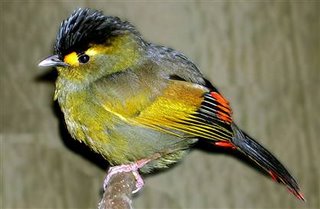 It isn't often that an entirely new species of bird is discovered so when it does happen it is big news. Professional astronomer, amatuer ornithologist and dedicated conservationist Ramana Athreya of Pune University, Pune, India has discribed a new member of the genus Liocichla in the extreme western part of the Northern India state of Arunachal Pradesh. This bird was known from an area of Arunachal Pradesh called the Eaglenest Wildlife Sanctuary for quite some time but carefull study was needed to determine if this population truly represented a new species or not. The new bird, named the Bungun Liocichla (Liocichla bungunorum), after the name of the local indigenous people, is the fourth named species in it's genus. The three other liocichla species include the Red-faced Liocichla (Liocichla phoenicea, widely distributed in South and Southeast Asia), the Emei-shan Liocichla (Liocichla omeiensis, retricted to a few forested moutainsides in China) and Steere's Liocichla (Liocichla steerii, a species endemic to the mountains of Taiwan and the subject of much of my own research). All these species frequent dense undergrowth and edge habitats in mountain forests, except for the Red-faced Liocichla which can also be found in lowland forests.
It isn't often that an entirely new species of bird is discovered so when it does happen it is big news. Professional astronomer, amatuer ornithologist and dedicated conservationist Ramana Athreya of Pune University, Pune, India has discribed a new member of the genus Liocichla in the extreme western part of the Northern India state of Arunachal Pradesh. This bird was known from an area of Arunachal Pradesh called the Eaglenest Wildlife Sanctuary for quite some time but carefull study was needed to determine if this population truly represented a new species or not. The new bird, named the Bungun Liocichla (Liocichla bungunorum), after the name of the local indigenous people, is the fourth named species in it's genus. The three other liocichla species include the Red-faced Liocichla (Liocichla phoenicea, widely distributed in South and Southeast Asia), the Emei-shan Liocichla (Liocichla omeiensis, retricted to a few forested moutainsides in China) and Steere's Liocichla (Liocichla steerii, a species endemic to the mountains of Taiwan and the subject of much of my own research). All these species frequent dense undergrowth and edge habitats in mountain forests, except for the Red-faced Liocichla which can also be found in lowland forests.
Typically discovery of a new species involves collection of a type specimen to be deposited in a museum collection. This makes the relevent biological material accessable for scientists all over the world so they may examine the data for themselves. However, Dr. Athreya felt culling an indiviudal bird or two from the population was unwise owing to the unknown status of the population therefore the description of this new species was made on the basis of measurements and photographs taken from live birds captured in the field. The primary tool of the 19th century ornithologist was the shotgun rather than a pair of binoculars. But, many modern ornithologists are more sensitive to environmental concerns and considerably more squeamish about killing birds (although there to date is little evidence that scientific collecting has had any long term harm on avian populations). Fortunately however the shotgun need not be necessary in every case. Modern comparative genetic analyses, such as DNA barcoding, is extremely useful in identifying relationships among species and DNA can be archived in museum freezers and sequences placed on online databases so that they can be available to other researchers. Tissue from feathers lost from the birds during capture could well provide a source of DNA that could further confirm the species status of this find.
I have a personal interest in this story as an ornithologist whose research deals with the Taiwan species of Liocichla, Steere's Liocichla. Dr. Athreya contacted several professional ornithologists, including myself, about a year ago asking for our input and advice on this species. There was a lively discussion at the time through the Oriental Bird Club's discussion list over the issue of scientific collecting. In the end however Dr. Athreya did the right thing for now in deciding not to collect museum specimens until further information became available about this species' status. The existing description of this species in the end made excellent use of limited information and luckily this species was so very different from it's congeners that even on the basis of some photographs and morphological measurments there is a strong case to be made for species status for this population. However, the genetic work should still be done. I would have loved to obtain some blood samples or other sources of genetic material from this species for analysis in my lab, however, this population is in a highly protected area and the Indian government is extremely sensitive and cautious when it comes to sharing biological samples with foreign researchers so in the end this was unfortunately not possible. But, there are many labs these days in India equiped to do such work (of course as long as they can depend on the good will of other countries to share samples with Indian researchers). It sounds like there is much exciting work ahead not just on this new species but on this unique forest ecosystem in Arunachal Pradesh. One can only hope that the forest habitat of the Eaglenest Wildlife Sanctuary can be subject to sound mangement practices.
Press coverage of this discovery can be found at BirdLife International, MSNBC and the BBC News. The description of this new species was published in the journal Indian Birds and is available online.